Despite its image as a high-tech country, a lot of Japan’s government paperwork still takes the form of bound collection of hard copies of legal documents. The National Diet Library has the responsibility of housing countless numbers of these collections.
However, like a fiery balrog, water is the bane of physical printed documents (which admittedly have a bit of a problem with fire, too). The National Diet Library occasionally has to deal with restoring books that have become wet before water damage sets in. Recently, the library revealed its simple, easy to copy technique for properly drying out a soggy book.
The library’s website lists spilled cups of water, ruptured pipes, leaky roofs, and malfunctioning sprinklers as probable causes of water damage, confirming our theory that the building does not, in fact, operate as a venue for raging after-hours keggers for Japanese politicians.
▼ A book, damaged by water or perhaps that blue liquid from diaper and tampon commercials
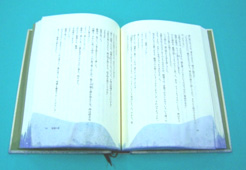
The procedure doesn’t call for any equipment you’re unlikely to have laying around you home or office, nor does it require any special training.
You’ll need:
– Cloth towel, preferably made of absorbent material
– Roll of paper towels or stack of printer paper
– Electric fan or hair dryer
– A few hard flat surfaces (cutting boards will do the trick)
– Paperweight or something similarly small and heavy
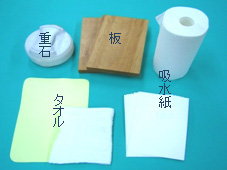
Start by pressing the towel onto the wettest parts of the page, to soak up as much of the liquid as initially possible.
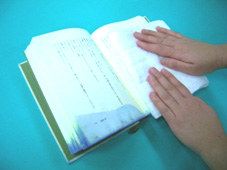
Next, place paper towels or printer paper between the pages of the book that are still wet, being carful not to jam so much in as to distort the shape of the book itself.
▼ Although, if the National Diet Library has talking books, as shown here, we really wonder why it matters if the pages are legible or not
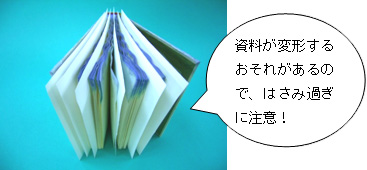
If the book’s cover is stiff enough to support its weight, stand the book on edge, with the wet portion at the top. If the cover is too soft for this, lay the book flat on the table. Turn on the fan or dryer and aim it at the book. Make sure the air flow is not so strong as to knock any standing books, and if using a dryer use only cold air, not hot.
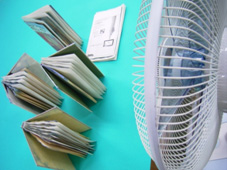
As they become damp, periodically replace the paper towels or printer paper inside the book as needed, until the moist portions of its pages no longer feel cold to the touch.
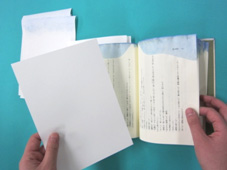
Once that happens, remove the drying papers, and place the book or books on a hard, flat surface to finish drying. Alternate layers of boards and books, with a single sheet of paper above and below each book to prevent sticking. To keep the books from warping, place the paperweight on top of the entire stack.
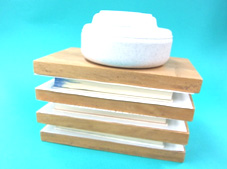
If complete drying takes more than a day, remove the books from the stack at least once every 24 hours and flip through the pages to make sure they’re not fusing together.
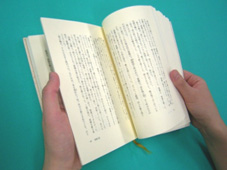
The library’s website goes on to list a few other points of advice. If, as a result of the moisture, mold has started to develop, the book should be isolated from other materials and the affected areas cleaned with an ethanol solution.
Photos tend to be printed on paper with a special coating, which is particularly prone to sticking to other similarly-coated surfaces. Should this occur, the pages can be separated using a spatula, although this also carries a risk of damaging the surfaces, and should be done with caution, if at all.
Finally, the National Diet Library, and we here at RocketNews24, take no responsibility for any problems that may occur with the above process, and stress that it is not to be used with materials that are delicate or have already reached an advanced stage of degradation.
In other words, this technique isn’t so much for your copy of the magna carta stained with fine port on as it is the 100 yen comic you spilled some canned beer on.
Sources: National Diet Library, Net Lab
Insert images: National Diet Library

 Manga water damage rescue tip lets us read our favorites without fear in the bathtub
Manga water damage rescue tip lets us read our favorites without fear in the bathtub How to resurrect a water-damaged book: Japanese bath fan’s freezer life hack
How to resurrect a water-damaged book: Japanese bath fan’s freezer life hack How to lady: Fascinating Meiji Era women’s book features hairstyles, history lessons, etiquette
How to lady: Fascinating Meiji Era women’s book features hairstyles, history lessons, etiquette 3 rules to make you a more productive writer, from Japanese novelist who wrote 25 books in 8 years
3 rules to make you a more productive writer, from Japanese novelist who wrote 25 books in 8 years Japanese Twitter shows us why people like buying well-loved used books
Japanese Twitter shows us why people like buying well-loved used books Harajuku’s new permanent Tamagotchi shop is filled with cuteness and a surprising lack of poop
Harajuku’s new permanent Tamagotchi shop is filled with cuteness and a surprising lack of poop Hayao Miyazaki says Happy New Year to Studio Ghibli fans with new art for Year of the Horse
Hayao Miyazaki says Happy New Year to Studio Ghibli fans with new art for Year of the Horse Starbucks Japan ready to get Year of the Horse started with adorable drinkware and plushies【Pics】
Starbucks Japan ready to get Year of the Horse started with adorable drinkware and plushies【Pics】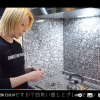 Host club royalty Roland demonstrates his night-time routine, claims it’s not dissimilar to yours
Host club royalty Roland demonstrates his night-time routine, claims it’s not dissimilar to yours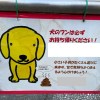 Japanese park’s English dog turd warning minces no words【Why does Engrish happen?】
Japanese park’s English dog turd warning minces no words【Why does Engrish happen?】 Japanese group to hold fashion show of colostomy bags and other stoma equipment in Paris
Japanese group to hold fashion show of colostomy bags and other stoma equipment in Paris 5 amazing health and beauty benefits of eating wasabi
5 amazing health and beauty benefits of eating wasabi We found possibly the quietest Japanese-style hotel in Tokyo’s bustling Shinjuku district
We found possibly the quietest Japanese-style hotel in Tokyo’s bustling Shinjuku district These Guys Keep All Their Cuteness Even When Cooked! We Try Deep-Fried Axolotl in Osaka
These Guys Keep All Their Cuteness Even When Cooked! We Try Deep-Fried Axolotl in Osaka We test out Daiso’s “High-Quality Stereo Earphones” and find a pair that actually impressed us
We test out Daiso’s “High-Quality Stereo Earphones” and find a pair that actually impressed us 7-Eleven Japan’s ramen-cooking robot whipped us up a bowl of noodles【Taste test】
7-Eleven Japan’s ramen-cooking robot whipped us up a bowl of noodles【Taste test】 Cyberpunk anime meets traditional culture in Ghost in the Shell gold leaf Japanese changing screens
Cyberpunk anime meets traditional culture in Ghost in the Shell gold leaf Japanese changing screens 7 great places to see Mt. Fuji from without having to climb it
7 great places to see Mt. Fuji from without having to climb it Hello Kitty Choco Egg figures are an adorable trip through three periods of Japanese pop culture【Pics】
Hello Kitty Choco Egg figures are an adorable trip through three periods of Japanese pop culture【Pics】 Japan’s otoshidama tradition of giving kids money at New Year’s gets a social welfare upgrade
Japan’s otoshidama tradition of giving kids money at New Year’s gets a social welfare upgrade Lacquerware supplier to emperor of Japan and Pokémon team up for new tableware
Lacquerware supplier to emperor of Japan and Pokémon team up for new tableware Sumo Sanrio! Hello Kitty and pals team up with Japan Sumo Association for new merch【Pics】
Sumo Sanrio! Hello Kitty and pals team up with Japan Sumo Association for new merch【Pics】 Can a dirty butthole make you filthy rich in Japan? We’re starting a New Year’s lottery experiment
Can a dirty butthole make you filthy rich in Japan? We’re starting a New Year’s lottery experiment 7-Eleven Japan starts new temporary luggage storage service in over 300 branches
7-Eleven Japan starts new temporary luggage storage service in over 300 branches Disillusionment at Tsukiji’s tourist-target prices led us to a great ramen restaurant in Tokyo
Disillusionment at Tsukiji’s tourist-target prices led us to a great ramen restaurant in Tokyo Starbucks teams up with 166-year-old Kyoto doll maker for Year of the Horse decorations【Photos】
Starbucks teams up with 166-year-old Kyoto doll maker for Year of the Horse decorations【Photos】 Tokyo considering law requiring more trash cans following litter increase in heavily touristed area
Tokyo considering law requiring more trash cans following litter increase in heavily touristed area Tokyo’s Tsukiji sushi neighborhood asks tour groups to stay away for the rest of the month
Tokyo’s Tsukiji sushi neighborhood asks tour groups to stay away for the rest of the month Nintendo’s Kirby now delivering orders at Kura Sushi restaurants, but not in Japan
Nintendo’s Kirby now delivering orders at Kura Sushi restaurants, but not in Japan Tokyo event lets you travel back in time, for free, to celebrate 100 years since Showa era start
Tokyo event lets you travel back in time, for free, to celebrate 100 years since Showa era start Sanrio theme park in Japan announces plans to expand into a Sanrio resort
Sanrio theme park in Japan announces plans to expand into a Sanrio resort Japan may add Japanese language proficiency, lifestyle classes to permanent foreign resident requirements
Japan may add Japanese language proficiency, lifestyle classes to permanent foreign resident requirements Survey asks foreign tourists what bothered them in Japan, more than half gave same answer
Survey asks foreign tourists what bothered them in Japan, more than half gave same answer Japan’s human washing machines will go on sale to general public, demos to be held in Tokyo
Japan’s human washing machines will go on sale to general public, demos to be held in Tokyo Japan’s deadliest food claims more victims, but why do people keep eating it for New Year’s?
Japan’s deadliest food claims more victims, but why do people keep eating it for New Year’s? We deeply regret going into this tunnel on our walk in the mountains of Japan
We deeply regret going into this tunnel on our walk in the mountains of Japan Studio Ghibli releases Kodama forest spirits from Princess Mononoke to light up your home
Studio Ghibli releases Kodama forest spirits from Princess Mononoke to light up your home Major Japanese hotel chain says reservations via overseas booking sites may not be valid
Major Japanese hotel chain says reservations via overseas booking sites may not be valid Put sesame oil in your coffee? Japanese maker says it’s the best way to start your day【Taste test】
Put sesame oil in your coffee? Japanese maker says it’s the best way to start your day【Taste test】 No more using real katana for tourism activities, Japan’s National Police Agency says
No more using real katana for tourism activities, Japan’s National Police Agency says Starbucks Japan reveals new sakura drinkware collection, inspired by evening cherry blossoms
Starbucks Japan reveals new sakura drinkware collection, inspired by evening cherry blossoms Updated cherry blossom forecast shows extra-long sakura season for Japan this year
Updated cherry blossom forecast shows extra-long sakura season for Japan this year Japanese Twitter shows us how to cool a beer in 10 minutes
Japanese Twitter shows us how to cool a beer in 10 minutes Japanese Twitter rolls eyes at book teaching “manners 90 percent of Japanese people don’t know”
Japanese Twitter rolls eyes at book teaching “manners 90 percent of Japanese people don’t know” Travel without a suitcase with 13 packing tips from a Japanese pro
Travel without a suitcase with 13 packing tips from a Japanese pro Studying kids from a Japanese publishing logo break free, go on adventure by reading books
Studying kids from a Japanese publishing logo break free, go on adventure by reading books Japanese Twitter user creates magical Peter Pan book with lifespan of its own, and it’s brilliant
Japanese Twitter user creates magical Peter Pan book with lifespan of its own, and it’s brilliant Gorgeous Japanese tatami reed book covers, card holders a fresh outlet for old-school style
Gorgeous Japanese tatami reed book covers, card holders a fresh outlet for old-school style Japanese parent finds a quick and easy way to get your kids to love reading from an early age
Japanese parent finds a quick and easy way to get your kids to love reading from an early age 10 tips to help you survive the Japanese summer
10 tips to help you survive the Japanese summer
Leave a Reply